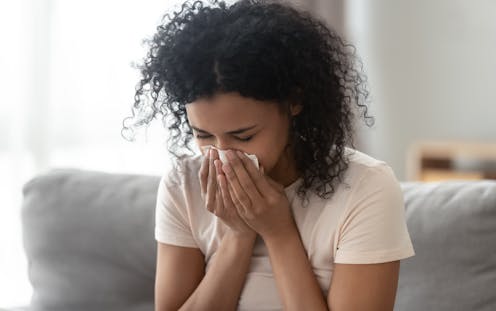How do hay fever treatments actually work? And what's best for my symptoms?
- Written by Mary Bushell, Clinical Assistant Professor in Pharmacy, University of Canberra

Spring has sprung and many people are welcoming longer days and more time outdoors. But for almost one in five Australians, spring also brings the misery of watery, itchy red eyes, a runny, congested nose, and sneezing.
Hay fever (also known as allergic rhinitis) is caused when an allergen enters the nose or eyes. Allergens are harmless airborne substances the body has incorrectly identified as harmful. This triggers an immune response, which leads to the release of inflammatory chemicals (mediators) – one of which is histamine.
Allergens that trigger hay fever differ from person to person. Common seasonal allergens include tree, grass and weed pollens (year-round allergens include dust mites, mould and pet dander). It’s now pollen season in many parts of Australia, with pollen counts at their highest and hay fever cases surging.
So what medicines can prevent or reduce hay fever symptoms, and how do they work?
Read more: Do I have COVID or hay fever? Here’s how to tell
Antihistamines
Knowing the release of histamine is a cause of hay fever symptoms, it’s unsurprising that anti-histamines are one of the most frequently recommended medicines to treat hay fever.
Antihistamines block histamine from binding to histamine receptors in the body and having an effect, reducing symptoms.
In Australia, we broadly have two types. The older sedating (introduced in the 1940s) and newer, less-sedating (introduced in the 1980s) antihistamines.
Less-sedating antihistamines used to treat allergic rhinitis include bilastine (Allertine), cetirizine (Zyrtec), loratadine (Claratyne) and fexofenadine (Telfast). Bilastine, which came onto the Australian market only last year, is only available from a pharmacy, on recommendation from a pharmacist. The others have been around longer and are available at supermarkets and in larger quantities from pharmacies. Cetirizine is the most likely (of the less-sedating antihistamines) to cause sedation.
The older sedating antihistamines (such as promethazine) cross the blood-brain barrier, causing drowsiness and even brain fog the next day. They have lots of side effects and potential drug interactions, and as such have little place in the management of hay fever.
The newer less-sedating antihistamines are equally effective as the older sedating ones.
Antihistamines are usually taken orally (as a tablet or solution) but there are also topical preparations such as nasal sprays (azelastine) and eye drops. Antihistamine nasal sprays have equal to or better efficacy than oral antihistamines.
The individual response to antihistamines varies widely. For this reason, you may need to trial several different types of antihistamines to see which one works best for you.
Increasing the dose of an antihistamine, or combining an oral and topical antihistamine, does not provide any additional benefit. Paying extra for a brand name doesn’t offer any more or less effect than the generic (both have the same active ingredient and are bioequivalent, which means they have the same outcomes for patients).
Steroid nasal sprays
If your symptoms don’t improve from antihistamines alone, a nasal spray containing a corticosteroid is often recommended.
Corticosteroids prevent the release of several key chemicals that cause inflammation. How they work is complex: in part, corticosteroids “turn off” the production of late phase inflammatory mediators (cytokines and chemokines). This reduces the future release of more inflammatory mediators, which reduces inflammation.
Corticosteroids and antihistamines have different mechanisms of action. Research shows corticosteroid nasal sprays are more effective than antihistamines in controlling an itchy, runny, congested nose. But when instilled into the nose, corticosteroids also reduce the eye symptoms of hay fever.
There are also nasal sprays that contain both an antihistamine and corticosteroid.
Read more: Sneezing with hay fever? Native plants aren't usually the culprit
While there are a range of corticosteroid nasal sprays containing different active ingredients, a large study published this year shows they are all about as effective as each other, and work best when they have been taken for several days.
Sodium cromoglycate
Another medicine used to treat hay fever symptoms is sodium cromoglycate, which is available as an eye drop and over-the-counter in pharmacies.
This medicine is known as a mast cell stabiliser. As the name suggests, it stabilises or prevents mast cells from breaking down. When mast cells break down, they release histamine and other chemicals that cause inflammation.
This eye drop is both a preventative and treatment medicine, usually used before allergies strike. Evidence shows it is effective at reducing the symptoms of allergic conjunctivitis (eye inflammation from allergies).
Decongestants
Decongestants constrict blood vessels. They can be taken orally, administered as a nasal spray, or instilled into the eyes. When administered into the eyes it will reduce redness, and when administered into the nose, it will stop it from running.
However, decongestants should be used for a short duration only and are not for long term use. In fact, if a nasal spray decongestant is used for more than five days, you can experience something called “rebound congestion”: a severe stuffy nose.
Saline
Saline (saltwater) nasal sprays or irrigation products are also available to flush out the allergens and provide hay fever relief. While there are not many studies in the area, there is evidence that saline irrigation may reduce hay fever symptoms. Saline is safe and is not associated with adverse effects.
If you’re suffering from hay fever symptoms and unsure what to try, talk to your prescriber or pharmacist, who can guide you through the options and identify the best one for your symptoms, medical conditions and medicines.
Allergen immunotherapy (or allergen shots) is another option hay fever sufferers may discuss with their doctors. However it’s not a quick fix, with therapy taking three to five years.
Read more: I’m considering allergen immunotherapy for my hay fever. What do I need to know?
Authors: Mary Bushell, Clinical Assistant Professor in Pharmacy, University of Canberra





